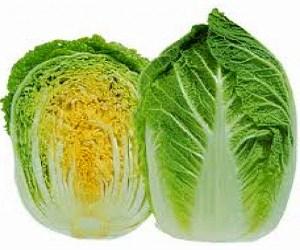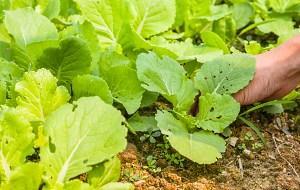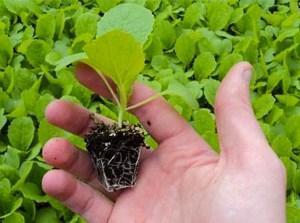Growing and caring for Chinese cabbage
 Peking cabbage is a cold-resistant, annual vegetable crop. The growing season does not exceed 2 months, from sowing seeds to the formation of a full-fledged head of cabbage. Growing Chinese cabbage in your beds will provide an opportunity to provide the whole family with family vitamins.
Peking cabbage is a cold-resistant, annual vegetable crop. The growing season does not exceed 2 months, from sowing seeds to the formation of a full-fledged head of cabbage. Growing Chinese cabbage in your beds will provide an opportunity to provide the whole family with family vitamins.
Upon reaching commercial qualities, depending on the variety, it may have:
- cylindrical;
- short-oval;
- long oval;
- dense or loose head of cabbage.
The average leaf length is 25 cm. The structure and color of the leaf plates can also vary significantly. The color range is from deep green to light green, the structure is slightly swollen and wrinkled.
Peking cabbage is grown in all types of protected and open ground as a compactor for tomatoes, zucchini, cucumbers, white cabbage or as an independent crop.
How to properly grow Chinese cabbage
Experienced gardeners and beginners are often tormented by questions related to the cultivation of new, unusual crops. Peking cabbage, in this regard, is no exception. Here are just a few of them:
- How to grow Chinese cabbage outdoors?
- Can plants be fed during the growing season?
- Which seedlings or seeds are preferred?
- How and when to water?
Despite the seeming unpretentiousness, the cultivation of Peking cabbage has its own nuances and small tricks, non-observance of which can significantly reduce the yield and nullify all the efforts made by the gardeners.
Seedlings or seeds
In what way, seedlings or seeds, to plant Peking cabbage depends on individual conditions:
- where and how the plant will develop: in the greenhouse, on the ridges, in the open field;
- what is the average length of the day, planting time (spring, late summer).
When planting and cultivating Peking cabbage in hot and / or dry times, the plant sharply turns into color and heads of cabbage are not formed. In addition, the culture begins to actively release arrows even under excessive illumination, including during the long white nights, which are typical for some northern regions, as well as Siberia.

Greenhouse
Seeds are sown in March, early April, late July, as well as in the first decade of August. Sowing pattern 20 × 40 cm. For planting in other time periods, only universal varieties are suitable, mainly hybrids, such as "Chinese Choice", "Lyubasha", "Naina F1";
Planting seedlings is carried out at the same time as the seeds, but since the plant has already passed the initial stage of growth (the formation of roots, the appearance of the first leaves), the crop can be harvested much earlier. Planting scheme 30 × 50 cm.
Do not sow seeds or plant cabbage seedlings after harvesting any cruciferous crops: radish, turnip, mustard, radish, as they are affected by common pests and diseases.
Open ground
Sowing seeds is carried out after warming up the soil, as a rule, this happens in early May. To obtain an autumn harvest, sowing can be started in the second decade of July. Pre-soaking of seeds is not required. Sowing scheme when growing as a salad culture 20 × 20 cm, if necessary, the formation of a head of cabbage - 35 × 35 cm, 50 × 50 cm.Seeding rate 4 g for every 10 m². The best results are obtained by sowing seeds on the ridges with their penetration into the soil by 10–15 mm.
Transplanting seedlings into the ground is carried out in early May. The planting pattern is 30 × 50 cm.When planting work, it is necessary to carefully monitor so that the root system is not damaged in any way; to facilitate this process, agricultural technicians recommend growing Chinese cabbage seedlings in separate peat pots or containers from which you can easily get the plant without deforming the root coma of earth.
To obtain high yields, it is necessary to monitor the correspondence of the selected variety to the planting time interval, that is, the early ones must be planted in the spring, and the later ones are closer to autumn and not vice versa.
Peking cabbage care
 Caring for Peking cabbage, as well as for any vegetable crop, consists of watering, weeding and feeding the plants.
Caring for Peking cabbage, as well as for any vegetable crop, consists of watering, weeding and feeding the plants.
To obtain good yields, an optimal balance between air temperature and humidity is extremely important. This statement is especially true during the formation of the head of cabbage and rosette.
Air temperature:
- during the day from 15 to 19 ° C;
- at night not lower than 8 ° C.
Air humidity:
- on a cloudy day 70%;
- sunny day 80%;
- at night about 80%.
Soil moisture 65%.
If these requirements are not met, the leaves are often affected by various diseases, such as gray, white and black rot. As a result, the plant does not develop normally and the formation of a head of cabbage does not occur.
Despite the fact that the culture needs well-moistened soil, it does not tolerate stagnant water.
Food
Peking cabbage prefers fertile soil, which is rich in nitrogen and calcium. But even if the land of the garden is poor in organic matter and trace elements, it does not matter.
The plant responds well to various feedings of both natural origin (mullein) and complex fertilizers:
- Autumn - for each m² you need to add 4.5 kg of manure, 1.5 dessert spoons of double superphosphate and 2.5 dessert. tablespoons of potassium sulfate. In the absence of the latter component, it can be replaced with ordinary wood ash at the rate of 1 liter can per 1 m² of soil;
- Before planting, a solution prepared from poultry droppings (water 10 liters and ½ kg of droppings) or from eggshells (30 grams of crushed shells should be insisted for 2 days in 5 liters of water) is introduced. If for some reason fertilizers were not added to the soil in the fall, then before planting, during spring digging, you need to add potassium sulfate, superphosphate and ammonium nitrate, each component is taken in the amount of 1 tbsp. l. for every m².
Peking cabbage has a high ability to accumulate nitrates; therefore, it is not recommended to apply fertilizers during the growing season. All fertilizers must be applied before the plant is planted on the site.
- Watering - in dry weather, it is necessary to water every day, it is better to do it by sprinkling, in this case the plants receive the required amount of moisture and at the same time the soil does not become overmoistened.
Peking cabbage pests and methods of dealing with them
In fact, there are not so many pests that infect Peking cabbage:
- cruciferous flea;
- slugs;
- cabbage butterfly;
- cruciferous bug.


Given that the culture has the ability to accumulate harmful substances in itself, non-chemical preparations are most acceptable for pest control. Popular methods are preferred, which, with regular use, give excellent results:
- Planting a crop between rows of tomato, onion or garlic significantly reduces the activity of the cruciferous flea. As a stronger remedy, it is recommended to spray the plants and soil between the rows with a special solution. To prepare it, you need to take green potato and tomato tops. Each component is 200 g and 2 large heads of garlic.Grind all ingredients and let them infuse for about a day. The Peking cabbage photo, which is located below, was planted exactly according to this principle - between two beds of onions.
- Careful and systematic removal of weeds also prevents damage to plants by the cruciferous flea beaver.
- After cabbage butterflies appear in the garden, it is necessary to examine the lower surface of the leaves as often as possible. When clutches are found, the eggs of the pest are destroyed. This method, although laborious, gives good results, significantly reduces the likelihood of the appearance of caterpillars.